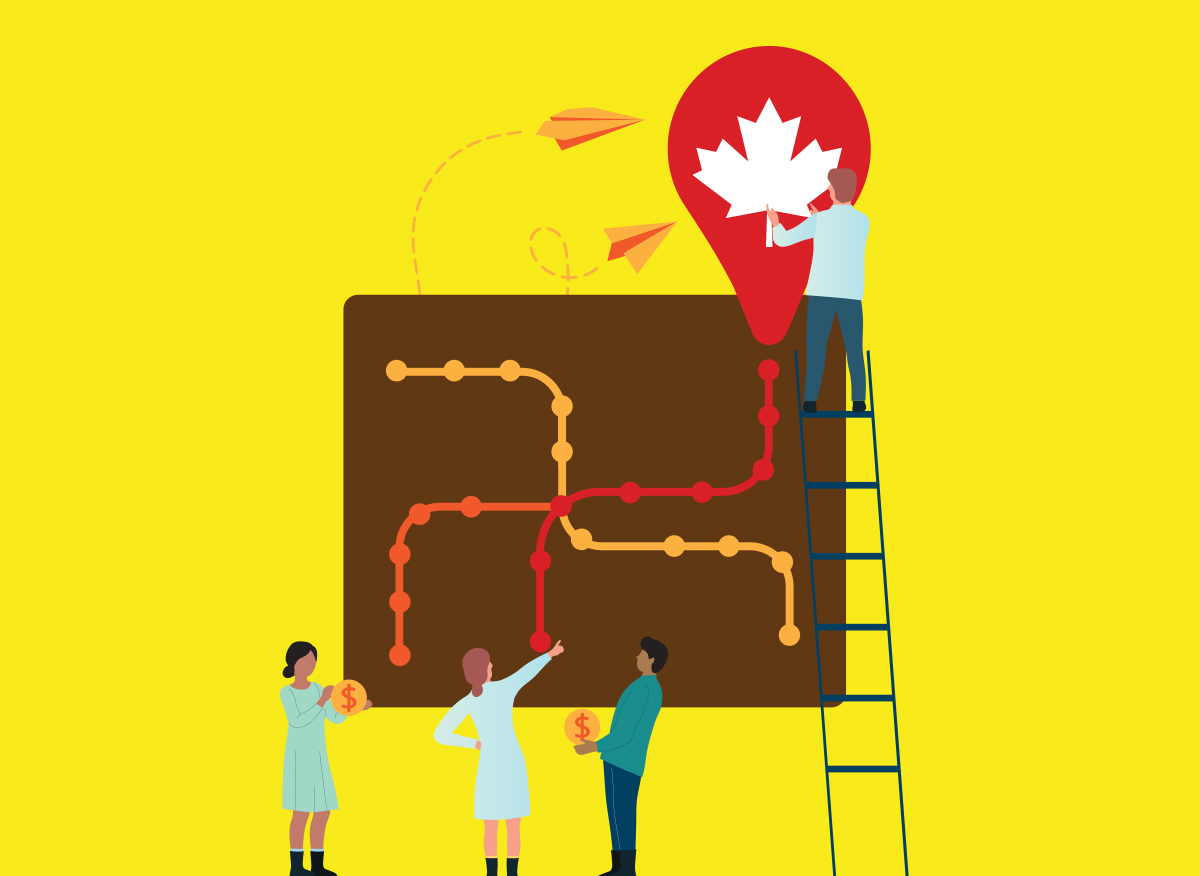The stories of international students and the policies that brought them to Canada are headline news. But international education wasn’t always at the forefront of Canada’s reputation abroad. Roopa Desai Trilokekar, a scholar of international education, explains the shifts in an interview with Academic Matters.

How did you become interested in studying international education?
I was an international student in the United States in the 1970s for seven years, and when I went back to India after my studies, I worked with the United States Education Foundation, which did binational educational exchanges between the U.S. and India. Working there, I saw how international politics was so intertwined with educational exchanges. At the same time, operationally, there was a conscious effort to keep academia separate from politics. I found this dynamic extremely fascinating.
What was the field of international education studies like when you started your work?
It was almost non-existent! There was very little Canadian presence in India or Asia more broadly at that time, especially when it came to higher education recruitment, and there was very little knowledge of or interest in Canadian higher education in India or elsewhere.
Back then, when it came to recruiting Asian students and Indian students in particular, the U.K., Australia, and the U.S. were very active. Canada was just “missing in action.” I was curious about the absence of Canada, particularly after I immigrated to Canada. My question was: If so many countries were invested in international education—not only in terms of recruitment of international students, but generally when it came to academic exchanges as a part of their international diplomacy—why was Canada absent? And for scholars at that time, this wasn’t a subject that was discussed, let alone studied.
There’s been a major shift over time in Canada, from then to now. There was nothing like what we have now in terms of scholarship, professional interest, and the way the subject has become part of the public discourse through the active engagement of newspapers and media.
There’s been a major shift over time in Canada, from then to now.
What about the public perception of international students in Canada? How have you seen that change?
When Canada first hosted international students, they were fully funded by the Canadian government as part of our development assistance program. Most of them came from developing countries—Commonwealth countries that we had affiliations with. The idea was to provide them higher education opportunities and for them to return home with these added qualifications. It was perceived as our “charitable” cause in engaging with the developing world. So there was a very positive perception in Canada of this program, but the numbers of students were very small. This shifted in the 1970s and 1980s, when Global Affairs Canada decided that education was part of our trade mission and there was little appetite to continue to fund international students with Government of Canada moneys. But the messaging was still positive, pro-multiculturalism, and pro-immigration. Students were seen as adding to the diversity and richness of our institutions, bringing in funds, and bringing in broader contributions to our communities.
Students were seen as adding to the diversity and richness of our institutions, bringing in funds, and bringing in broader contributions to our communities.
It was during the time of Stephen Harper, that immigration and international education policies got tightly interlinked. In 2016, the federal Immigration Minister, John McCallum, labeled international students as “golden.” He said: “I believe international students are among the most fertile source of new immigrants for Canada.” The perception of international students was very positive. They were interested in coming to Canada, they were paying their way through school, and then working in the Canadian labour market. Canada did not have to spend money or invest in them, but we were getting high returns, especially in terms of economic benefits from their tuition fees and other spending.
However, this narrative also altered over time. This is because studies started showing that international students were underperforming in the Canadian labour market, which worried Immigration, Refugees and Citizenship Canada (IRCC). The other thing was COVID, which I think shifted the discourse on international students. During COVID, Canadians had financial issues in our communities. More people were going to food banks. Housing prices were hitting all of us. Unethical players were going unchecked in the student recruitment market. More institutions turned to public-private partnerships that brought in many more students than before. The growth of students skyrocketed, and it was a very different student population coming in. They were not the master’s or doctoral students of decades past, or the new international students in high schools. They were largely coming to colleges or private institutions. These students were told that student visas were the pathway to Canadian immigration. The combination of these factors started changing the discourse on international students. We also started seeing many more stories in the media about the exploitation of international students, which portrayed a very different image of international students than we had in the past.
What research questions does the current moment spark for you, during a time of international student caps and more discussion about the conditions they face?
I’m very curious about these most recent shifts in policy and public perception around international students. How did we go from a policy that encouraged more international student enrolments and perceived international students as our future “golden immigrants” to one where the government now wants to cap numbers and even encourage more international students to return home after study? What created that shift politically and socially?
This is very interesting because as recently as during the COVID period, Canadian policymakers took leadership in being extremely proactive in supporting international students’ work in Canada, at a time when other countries were far more restrictive about closing their borders, like Australia and New Zealand among many others. So why the big shift now?
Immigration is a very important policy file in Canada, so I am extremely curious as to how education policy is shaping and reshaping this policy arena. Interestingly and ironically, this makes international student recruitment a policy that sometimes has very little to do with education.
When it comes to international education, the tensions between the federal government and the provinces are also very interesting to me. Each holds the other responsible when things do not add up, but there’s very little policy coordination between them. There’s also very little coordination within the federal government between departments that deal with immigration and global education, for example. I find the dance between the two governments very fascinating because it makes the Canadian dynamic unique in comparison to other countries.
This is why I am also curious about how Canada compares to other jurisdictions. Of course, countries often follow similar policy patterns and borrow policy from each other. So one can study the origins and paths of how policy flows from one country to another. For example, Canada follows Australia when it comes to international student recruitment, and now Germany is following our model when it comes to immigration and its link to the recruitment of international students.
What are you learning from international students about how they see themselves in this web of policies?
International students live within our communities. There has been a lot of discussion more recently about what the response of the community has been to the influx of international students, not just the universities and colleges that are hosting these students. Following an International Student Summit in Brampton in 2021—which I facilitated—there is interest in looking at working collaboratively with other organizations within the community to see their engagement, their role, and how they perceive their role in relation to international students.
One the one hand, I am very curious to see how these community organizations engage and support international students, but on the other hand I am equally curious as to how these engagements also shift the role of universities and colleges in supporting international students. Another colleague, Lisa Brunner at the University of British Columbia, highlights how the postsecondary sector has now become the new gatekeeper of immigration. I don’t think that’s the role we had envisioned for postsecondary education, nor do I think of it as part of their mission. How will this change their relationship with and to international students?
Another issue related to the international student experience links to broader conversations on equity, diversity, and inclusion on our campuses. As equity, diversity, and inclusion (EDI) are encouraged at different levels within our institutions today, there continues to be silence on how we engage with international students as part of our “EDI population.” We are still so resistant to discussing racism, issues of equity and inclusion in relation to international students. This is an area that needs new leadership. When we talk about EDI, we have to think about it from an international perspective, from a decolonial lens, and from the perspectives of different and distinct international student identities.
What should policymakers be thinking about regarding international education?
Ironically as a country welcoming so many diverse immigrants, I think in Canada, we’re very provincial, very parochial, and very insular. We think of what benefits us. We rarely look with a comparative lens to understand broader international landscapes. When it comes to international education, why does Canada want to engage in international education and recruit international students? Don’t we also want to invest in broader academic exchanges? Policymakers must engage with comparative research and scholarship in international education and develop broader long-term perspectives on the value and role of international education. This also means that on one hand, we need to rethink our global engagement and on the other, our funding model for higher education in Canada.
Policymakers must engage with comparative research and scholarship in international education and develop broader long-term perspectives on the value and role of international education.
My research is focused on the macro policy level, and some fascinating issues arise for future study. But equally important for policymakers is research in understanding the international student experience. International students are far from the monolith we imagine. Today, they represent a wide diversity of bodies, identities, and narratives. For sound international student policy, we need a better understanding of this changing population.










